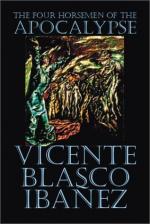At the end of the afternoon, he left the studio, accompanied to the elevator by the lamentations of Argensola. To think that he could not join that expedition! . . . He believed that he had lost the opportunity to paint his masterpiece.
Just outside of his home, he met Tchernoff. Don Marcelo was in high good humor. The certainty that he was soon going to see his son filled him with boyish good spirits. He almost embraced the Russian in spite of his slovenly aspect, his tragic beard and his enormous hat which made every one turn to look after him.
At the end of the avenue, the Arc de Triomphe stood forth against a sky crimsoned by the sunset. A red cloud was floating around the monument, reflected on its whiteness with purpling palpitations.
Desnoyers recalled the four horsemen, and all that Argensola had told him before presenting him to the Russian.
“Blood!” shouted jubilantly. “All the sky seems to be blood-red. . . . It is the apocalyptic beast who has received his death-wound. Soon we shall see him die.”
Tchernoff smiled, too, but his was a melancholy smile.
“No; the beast does not die. It is the eternal companion of man. It hides, spouting blood, forty . . . sixty . . . a hundred years, but eventually it reappears. All that we can hope is that its wound may be long and deep, that it may remain hidden so long that the generation that now remembers it may never see it again.”
CHAPTER III
WAR
Don Marcelo was climbing up a mountain covered with woods.
The forest presented a tragic desolation. A silent tempest had installed itself therein, placing everything in violent unnatural positions. Not a single tree still preserved its upright form and abundant foliage as in the days of peace. The groups of pines recalled the columns of ruined temples. Some were still standing erect, but without their crowns, like shafts that might have lost their capitals; others were pierced like the mouthpiece of a flute, or like pillars struck by a thunderbolt. Some had splintery threads hanging around their cuts like used toothpicks.
A sinister force of destruction had been raging among these beeches, spruce and oaks. Great tangles of their cut boughs were cluttering the ground, as though a band of gigantic woodcutters had just passed by. The trunks had been severed a little distance from the ground with a clean and glistening stroke, as though with a single blow of the axe. Around the disinterred roots were quantities of stones mixed with sod, stones that had been sleeping in the recesses of the earth and had been brought to the surface by explosions.
At intervals—gleaming among the trees or blocking the roadway with an importunity which required some zigzagging—was a series of pools, all alike, of regular geometrical circles. To Desnoyers, they seemed like sunken basins for the use of the invisible Titans who had been hewing the forest. Their great depth extended to their very edges. A swimmer might dive into these lagoons without ever touching bottom. Their water was greenish, still water—rain water with a scum of vegetation perforated by the respiratory bubbles of the little organisms coming to life in its vitals.




